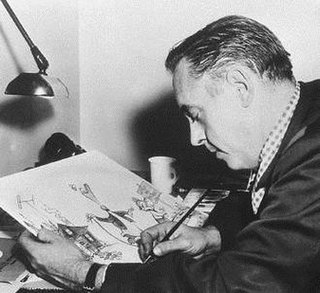
Frank Tashlin, also known as Tish Tash and Frank Tash, was an American animator and filmmaker. He was best known for his work on the Looney Tunes and Merrie Melodies series of animated shorts for Warner Bros., as well as his work as a director of live-action comedy films.
The Van Beuren Corporation was a New York City-based animation studio that produced theatrical cartoons as well as live-action short-subjects from the 1920s to 1936.
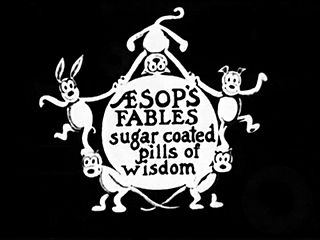
Aesop's Fables is a series of animated short subjects, created by American cartoonist Paul Terry. Produced from 1921 to 1934, the series includes The Window Washers (1925), Scrambled Eggs (1926), Small Town Sheriff (1927), Dinner Time (1928), and Gypped in Egypt (1930). Dinner Time is the first cartoon with a synchronized soundtrack ever released to the public.

Farmer Al Falfa, also known as Farmer Alfalfa, is an animated cartoon character created by American cartoonist Paul Terry. He first appeared in Down On the Phoney Farm (1915), a short Terry cartoon distributed by the Thanhouser Company. Next came a series of shorts produced by Terry for Bray Studios, starting with Farmer Al Falfa's Cat-Tastrophe (1916).

Dinner Time (1928) is an American animated short subject produced by Amadee J. Van Beuren, directed by Paul Terry, co-directed by John Foster, and produced at Van Beuren Studios. Josiah Zuro arranged and conducted the "synchronized" music score. The film is part of a series entitled Aesop's Fables and features the Terry creation Farmer Al Falfa who works as a butcher, fending off a group of pesky dogs.

The Little King is an American gag-a-day comic strip created by Otto Soglow, which ran from 1930 to 1975. Its stories are told in a style using images and very few words, as in pantomime.

Paul Houlton Terry was an American cartoonist, screenwriter, film director and producer. He produced over 1,300 cartoons between 1915 and 1955 including the many Terrytoons cartoons. His studio's most famous character is Mighty Mouse, and also created Heckle and Jeckle, Gandy Goose and Dinky Duck.
Thomas Augustin Palmer was an Italian-American animator, cartoon director, and U.S. training film supervisor. He was active in the animation industry throughout the 1920s and 1930s and was best known for his animation work at Walt Disney Productions. He spent a good chunk of his later career directing training films for the United States Army.
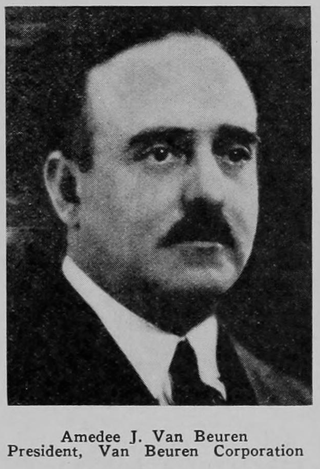
Amedee J. Van Beuren was the producer of Frank Buck's first three films, as well as many cartoons and short films.
Ted Eshbaugh was an American animation filmmaker, best known as one of the first filmmakers to experiment with color sound cartoons in the early 1930s, which included Goofy Goat and The Wizard of Oz.

Circus Capers is a 1930 animated short film made by The Van Beuren Corporation and distributed by Pathé Exchange. The film, which featured the characters Milton Mouse and Rita, is part of the early sound cartoon series entitled Aesop's Sound Fables, though it is not based on an Aesop fable.

A Close Call is a 1929 animated short film which is part of the early sound cartoon series entitled Aesop's Sound Fables. It was produced by The Van Beuren Corporation and released by Pathé Exchange.

Good Old Schooldays is a 1930 American film produced by The Van Beuren Corporation and released by Pathé Exchange. The film, which features Willie Jones and other animals, was directed by John Foster and Mannie Davis, with synchronization by Gene Rodemich.

The Iron Man is a 1930 animated film which was directed by John Foster and Harry Bailey. It was produced by The Van Beuren Corporation, and released by Pathé Exchange, a film distributor which had the newsreel Pathé News.
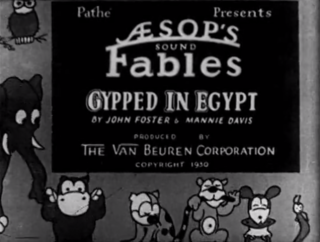
Gypped in Egypt is a 1930 animated short film directed by John Foster and Mannie Davis. The film was produced by The Van Beuren Corporation and released by Pathé Exchange, a film distributor with a newsreel titled Pathé News.
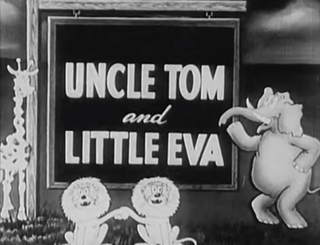
Dixie Days is a 1930 animated short film which was produced by The Van Beuren Corporation and released by Pathé Exchange.
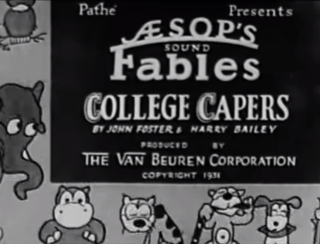
College Capers is a 1931 animated short film produced by The Van Beuren Corporation and released by the film distributor Pathé Exchange.
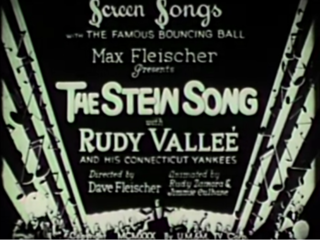
The Stein Song is a 1930 animated short film which is presented by Max Fleischer and was directed by Dave Fleischer. The film, which was animated by Rudy Zamora and Jimmie Culhane, features a sing-along version to "The Stein Song", which was written by Lincoln Colcord and was originally published in 1910. The song is also the school song for the University of Maine.

Western Whoopee is a 1930 animated short film directed by John Foster and Harry Bailey. It is part of the early cartoon series Aesop's Sound Fables. It was produced by The Van Beuren Corporation and released by the film company Pathé Exchange. It, like other Sound Fables at that time, features Milton Mouse and Rita, who resemble Mickey and Minnie Mouse to such an extent that Disney sued Van Beuren for the resemblance.

Milton Mouse is an animated character created at Fables Studios for Paul Terry's cartoon series Aesop's Fables. The character was introduced in 1921, and appeared in dozens of cartoon shorts through 1931. Milton often appeared alongside a girlfriend mouse, usually named Rita.


















